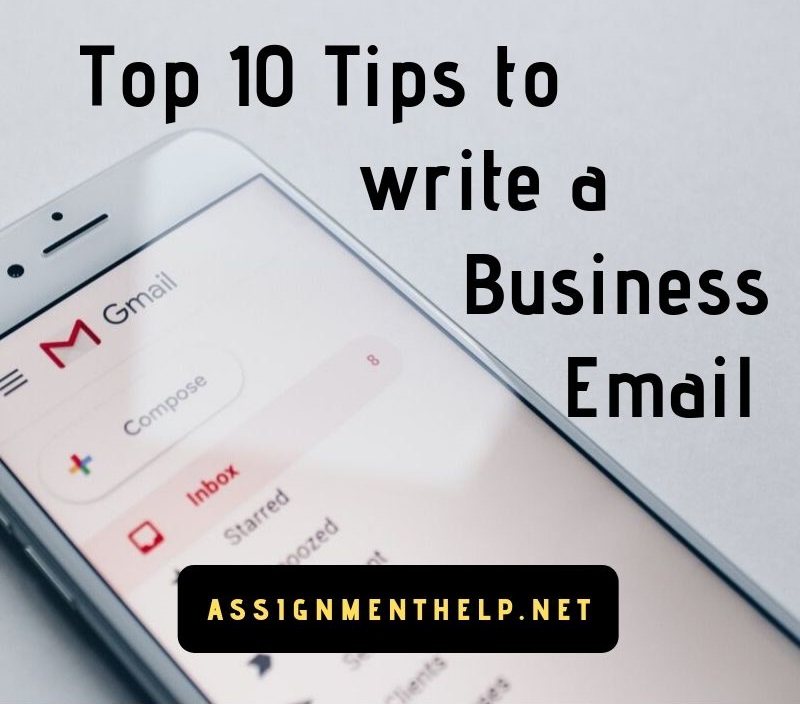Top 10 Tips to Write a Business Email
There is no doubt about the fact that texting and social media has become the most common form of communication in today’s world. In fact, with the arrival of internet messaging apps like WhatsApp and hike, human beings have begun to completely rely on texting. It has come to such a state that one can find people texting each other while being in the same room. But despite this huge popularity of these instant messaging apps and texting, the professional world has still managed to stay away from texting and these apps.
Email remains the most common and most relied-on form of communication in the professional world. One can say that because texting is so extensively used in casual conversations, it does not have the professional touch that email continues to have. Writing and receiving emails is an inevitable part of the business world. The email form a major part of the correspondence in the business world.

You might think that you have got the art of writing an email just perfect, but it might not be the case. It is quite normal for someone to think so because of the huge number of emails that we all write to our loved ones every day. But you need to understand that while writing an email to a friend of yours or someone from your family, you can be as casual as you want, but while writing a business email or a professional email, you need to be cautious of what you write and how you write it. An important thing to note is that a business email is a different type of email altogether.
In today’s world, it is very important for every professional to know how to write a business email. It is high time for everyone to look in retrospect and think about every time they did not hear back from a recruiter after emailing, or when they did not hear back after pitching a business opportunity to a professional. Every time something like this happens, we all delegate the blame to the timing or lack of experience or a hundred other things. But it is high time to consider the format and the tone in which the email was written. You might think that there is no real guideline to write a business email, but there exists a protocol for it that needs to be followed.
Here are some tips that you can follow to write effective business and professional emails:
1. Write an effective subject line
While writing a business email, a subject line is very important. It is the first thing that the recipient of your email is going to read. If you are sending an email to a new client for the first time, whether he is going to open your mail or not depends a lot on your subject line. If you are sending the email to a new contact and the mail does not contain a subject line, the recipient might consider spam and you might never get the response that you would be keenly waiting for. Always make sure to include keywords in the subject line. Doing so makes it easier for the recipient to search for your email among thousands of them whenever he needs to follow up or respond. Also, make sure that you do not write a subject line just for the sake of including it. The subject line should include words that summarize your message or the topic of your email.
2. Always greet the recipient in the email
The way you greet the recipient depends a lot on the relationship that you share with the recipient, but starting with a formal greeting is always a safer bet. It is important to have a contact name so that you can use it in the email unless the recipient is absolutely unknown. You do not want to get the gender or the spelling of his or her name wrong. It is one of the easiest ways to annoy the recipient and it might even result in the recipient not reading the rest of the email. Also, failing to do so reflects carelessness on your part, which becomes a major problem when you send the email to a business client.
3. Try to put the main point in the opening sentence
Always respect the time of the recipient. You should keep in mind that the person you are sending the mail to is not necessarily free. Therefore, it does not help if you write an email with huge paragraphs. Also, even if you write short emails, you should try to put the main point in the very first sentence of the email. It is one of the most important things that you should keep in mind while writing a business email. Most of the professionals these days remain busy throughout the workdays. Therefore, you should try to present the main point in the first sentence. Not everyone that you send an email to is going to read your entire mail. If you want the recipient to read your entire mail, you need to make your starting line catchy enough. It should be catchy enough to make the reader go further in the mail.
4. Always be professional
Always keep in mind that you are writing a business email and not to a family member. Therefore, you need to keep the tone of the email formal. Most of the times, the tone comes naturally based on who you are talking to, but if it does not come naturally to you, you should be cautious while writing the email. Make sure that you do not use exclamation marks excessively as you would use in a casual conversation. Keep reminding yourself that this is isn’t texting. Do not use emoticons or smileys. However, it is not always imperative to be formal in a business email. It mostly depends on the rapport and relationship that you share with the recipient of the email.
5. Learn to deliver bad news
We all know that delivering bad news is not the easiest of jobs. But when you work in a professional capacity, it becomes part of your job. Few years in the business environment, and you will find yourself delivering bad news every now and then. You need to learn to do so. One of the best ways to do so is to provide positive or neutral information at first. You do not want to give the negative news first up. Once you have given the recipient something neutral or positive to read, then you give him the negative news. Also, make sure that you explain why it is happening and why it is important that it happens. You should make all of this perfectly clear. The next part of your email should be a potential solution. You should provide the recipient with a solution that you think he can apply to move ahead in his life.
Keep in mind that you cannot really do anything about the loss or the scope of the problem. You do not need to try to minimize the scope of the problem. All you need to do is send the email in such a way that the recipient gets an impression that you care and you are suggesting an action to fix it.
6. Proofread your email
Never send a business email before proofreading it. No matter how great you are with the language, no matter how good you are with words and grammar, proofreading the email before finally sending it to the recipient never hurts. You should keep in mind that once you click on that send icon, you cannot do anything about any mistakes that you may have committed while writing it. Therefore, it is always a safer bet to make sure that there are not any mistakes in the first place. We all make mistakes every now and then. You might think that there is nothing wrong with the email that you have written, and in this confidence, you might just overlook the punctuation or that grammatical mistake staring you right in the face. You should always check for the punctuations and any typos that might have occurred or any inappropriate word usage. If you click on the send icon and there are any mistakes, you come across as not just incompetent but also careless. And when you work in a business environment, it is the last thing you want.
7. Say Thanks
Always remember to say thanks to somebody who replies to you. Your job does not end with sending an email. When someone replies instantly to you, you should always say something like, ‘Thank you for your prompt reply’. Even if the reply is not prompt, you must thank the person. In the professional world, that’s how you build relationships. You might think that this is a very trivial thing. But when you are trying to start a conversation with a new client or recruiter, things like these matter a lot. You should always remember that it is very important to start and end a conversation on a positive and cheerful note. Doing so helps you in building a good impression of yourself, which is very important as far as the business and professional world is concerned. Including a cheerful salutation in your email makes your recipient feel valued. It makes him feel that you value his response and therefore, makes him more tempted to give a reply that favours you. However, at the same time, make sure that you do not sound petty. Say thanks when you mean it. Do not do so just for the sake of including it in the email. At times, people tend to overuse words like ‘thanks’ and ‘please’, which makes them come across as petty. Try to avoid that.
8. Be short and concise
Always keep reminding yourself that you are working in a business environment. In that world, no one wants to read a long email. Therefore, you should stick to the point and keep the subject matter or body of your email as short as possible. If your message is long and you cannot keep it short, divide it into paragraphs so that it becomes easier for the recipient to look at the mail and understand it. Although it is not a research paper that you are writing, there is still a style that you need to adhere to.
If your message is a long and complex one, you should deliberately define the overall purpose of the mail in the starting itself. By doing so, you make sure that the recipient gets the overall message no matter how complex your message is.
People do not really have time to read all the emails that they receive as everybody receives a lot of emails every day. Therefore, when you declare the purpose of the email in the starting, you make sure that the person reads the entire message.
9. Write a closing to your email
Make sure that you write a closing to the mail before sending it. You can end the email by reminding the recipient about the central issue of the email and conclude with a call to action. Even if you simply write something like, ‘Looking forward to a positive response’ or ‘Looking forward to hearing from you soon’, it helps and makes a difference. Writing a closing like this sets up an expectation that the recipient must respond to you. It increases the chances of you getting a prompt reply from the recipient. If your email is about a matter that needs you to take immediate action, you can even write the closing in order to make the recipient reply within the time.
Also, you need to close with something like ‘Yours sincerely’ or ‘Best regards’ or ‘Take care’. All of this depends upon the kind of relationship that you share with the recipient. But make sure that your closing aligns with the nature that the two of you share. You do not want to come across as impertinent.
10. Decide on attaching any images
Whether you can or cannot attach any images or any other attachment to the email, depends on who you are sending the email to. If you are sending the email to a recruiter, you should not attach your resume or portfolio or cover letter beforehand. All it does is annoy the recipient and pile up their accounts like emails from hundreds of other candidates. What you should do is offer to send a copy of your resume if the recruiter asks you to do so. If the recruiter is interested and wants to see your information, he will ask for it… and that is the right time to send your information.
However, if you are sending the email to one of your clients, with whom you have already had a conversation about the subject, you can choose to send pictures or attachments of any other kind. But make sure that you do not load the entire email with pictures and other attachments. You do not want to send everything at once.


